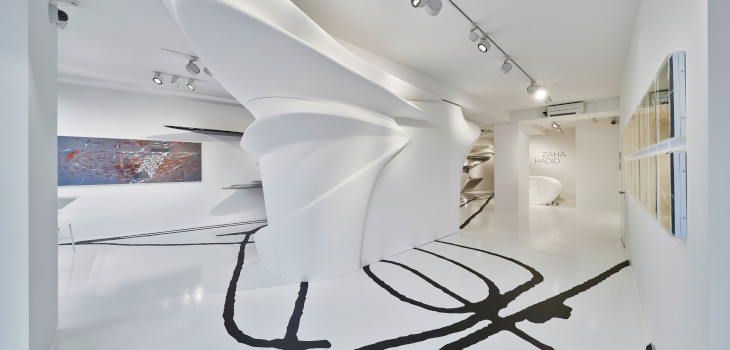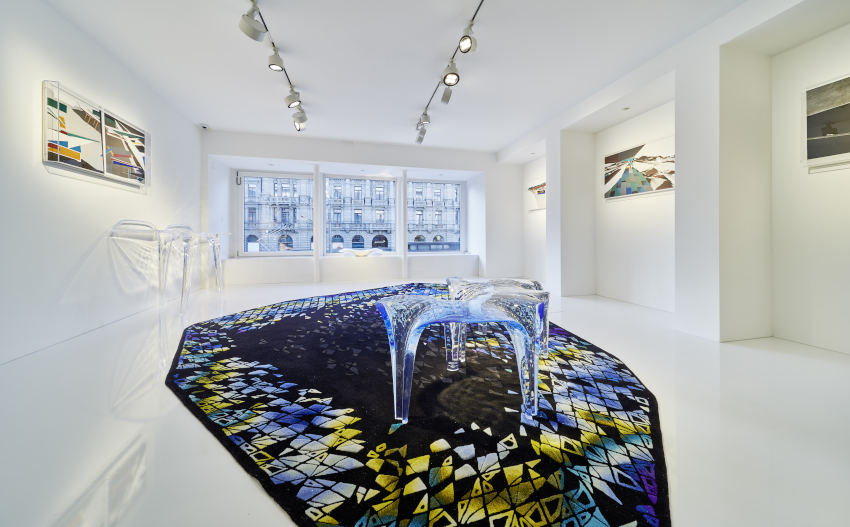Zaha Hadid, The Visual Artist
May 5, 2021
Most people know Zaha Hadid as an architect. When she died in 2016, at the young age of 65, Hadid was one of the most sought-after architects in the world. She was renowned both for her extraordinary eye, and her sense that architecture is an active part of the life and imagination of the community it inhabits. Her many world-famous buildings—such as the Broad Art Museum in East Landing, Michigan; the London Aquatics Center; the Museo nazionale delle arti del XXI secolo (MAXXI) in Rome; and the Guangzhou Opera House—not only seem inspired, they are also inspiring. They are not only contemporary looking, they serve as looking glasses through which to imagine possible futures. Yet, what many of her most ardent admirers do not even know about Hadid is that she was also an accomplished visual artist. She did not consider her architectural designs separate from her relationship with visual art. Rather, she considered all of her creative efforts to be part of a symbiotic dialogue. Perhaps the clearest elucidation Hadid offered us during her lifetime of her overall aesthetic approach was in 2010, when she mounted Zaha Hadid and Suprematism at Galerie Gmurzynska in Zurich. This singular exhibition featured a stunning selection of works by several of the key protagonists of Russian Suprematism juxtaposed alongside artworks and designs by Hadid, including a dynamic, large-scale, site specific installation of exploding black rays. Seeing her work in this context immediately clarified the lineage Hadid shares with the Suprematist belief that visual and geometric structures are linked to social structures that help guide the evolution of human culture. This summer, to mark the five-year anniversary of her death, Galerie Gmurzynska will present a posthumous Hadid exhibition titled Zaha Hadid—Abstracting the Landscape. Featuring many never-before-shown artworks, models, and designs, this exhibition not only promises to bolster her legacy as a multidisciplinary visionary, it could also cement Hadid as a key, global figure in 21st century abstract art.
Modernist Lost & Found
Hadid was born in Baghdad, Iraq, in 1950. She enrolled in architecture school at age 22, but was unlike many of her fellow students in at least one key way: she did not just want to design buildings, she wanted to discover how the architectural objects she designed could transform the cities they inhabit. As part of her studies, Hadid took drawing and painting classes—all architecture students do at some point; it is integral to their daily practice. Hadid, however, embraced painting not only as a practical tool, but as a way of challenging her perceptions and biases. Modernist abstraction was her preferred visual vocabulary, and what she called her investigation of “the aborted and untested experiments of Modernism” led her to discover Suprematism, and its founder and chief practitioner Kazimir Malevich.

Zaha Hadid, April 2021, Courtesy Galerie Gmurzynska © Zaha Hadid Design
Twenty years later, well on her way to establishing her global reputation as a genius, Hadid collaborated on the monumental Guggenheim exhibition The Great Utopia, which revisited, celebrated, and contextualized Suprematist theories for a new age. In a 2014 artist talk at the Tate, Hadid spoke about the lessons learned from that exhibition. She described Suprematist compositions as being freed from gravity: horizontal forms could be flipped into vertical forms and vice versa. She also spoke of space and scale being upended. Most importantly, she shared the idea of “explosion,” or the deconstruction and reorganization of ideas. “The influence of Malevich on me was not only in the way we did the three-dimensional drawings or the way we thought about gravitational forces,” Hadid said, “but also the way it impacted on the reorganization of the plan.”

Zaha Hadid, April 2021, Courtesy Galerie Gmurzynska © Zaha Hadid Design
A Utopia of One
Reorganization seems somehow essential to all of the work Hadid made. Looking back at the thought experiments of the past, it is easy to assume that every cultural movement that ever fell from favor must have done so for logical reasons: maybe its potential was exhausted, or perhaps market forces played a hand. Hadid was not hindered by such conceits. She exploded and reorganized conventional wisdom about modernism. She looked at thinkers like Malevich, Kandinsky, Sophia Delauney, Anni Albers, Piet Mondrian and Le Corbusier, and was able to divorce their idealistic visions from the politics and world events that caused them to be forgotten. She separated Suprematism from the failed utopia from which it grew. Simultaneously, Hadid grasped the artificiality of the perceived separations between the fields of architecture and art, and between so-called realism and abstraction. She put into practice the belief that abstraction is logical, logic is beautiful, and anything beautiful is real.

Zaha Hadid, April 2021, Courtesy Galerie Gmurzynska © Zaha Hadid Design
Ultimately, I believe Hadid could be called a utopian artist. But rather than putting her faith in doomed social utopias, Hadid showed us through her art and architecture that all cultural structures and aesthetic positions are best understood in the context of a utopia of one. The selection of works on view this summer in Zaha Hadid—Abstracting the Landscape at Galerie Gmurzynska introduce viewers to the incredibly broad range of objects Hadid brought into being, while also illustrating what all of these varied creations share in common. All of the objects in the show were conceived as answers to the question of what a picture, or a sculpture, or a piece of furniture, or an architectural environment might mean not to society, but to one person—a singular, logical, beautiful human being. If ever the plan given to Hadid was to design something that served a business, or an institution, or an activity, she reorganized the plan, and instead designed something that served a person. That principle of fostering singular human utopias enabled Hadid to create an oeuvre defined by its ability to surprise and inspire. Her lasting gift to contemporary abstraction is the reminder that possibility is as important as practicality, so whenever the plan fails to serve people, explode the plan.
Featured image: Zaha Hadid, April 2021, Courtesy Galerie Gmurzynska © Zaha Hadid Design
All images used for illustrative purposes only
By Phillip Barcio






